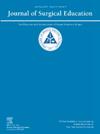Efficacy of a Targeted Foley Catheter Education Program
IF 2.1
3区 医学
Q1 EDUCATION, SCIENTIFIC DISCIPLINES
引用次数: 0
Abstract
Objective
To improve surgical interns' confidence and competency in urinary catheter insertion and management, we designed an educational module addressing their common challenges, such as difficult placement and catheter discomfort.
Methods
A 1-hour urinary catheter educational session was delivered to first-year surgical residents in the 2023-24 and 2024-25 academic years. The curriculum covered urethral anatomy, catheter types, managing urinary retention, troubleshooting measures, and management of catheter-related discomfort. Pre- and postcurriculum surveys assessed confidence levels with aspects of catheter management. Trends in catheter-related consultations by surgical services were examined 6 months before and after the education session. Paired t-test used to determine statistical significance. Significance set at p < 0.05.
Results
About 24 nonurology surgical residents completed the pre- and postsurveys. Respondent reported a mean confidence increase from 3.04 ± 0.85 to 3.92 ± 0.72 in placing routine foley catheters (p < 0.05), 3.38 ± 0.97 to 4.08 ± 0.58 for male urethral anatomy knowledge (p < 0.05), 3.29 ± 0.99 to 3.83 ± 0.70 for female urethral anatomy knowledge (p < 0.05), and 2.08 ± 0.83 to 3.75 ± 0.61 for managing foley associated discomfort (p < 0.05). There was a decrease in the number of catheter consultations placed to urology by surgical services in the 6 months following the education session.
Conclusion
Our findings underscore the feasibility of implementing a foley catheter module and its potential to enhance resident confidence and reduce confusion regarding catheter management. Furthermore, the decrease in difficult catheter placement and catheter discomfort consultations may suggest early curricular efficacy in bolstering interns’ catheter troubleshooting skills.
有针对性的Foley导管教育计划的效果
目的为提高外科实习生对导尿置放和管理的信心和能力,针对导尿置放困难和导尿不适感等常见问题,设计一套教育模块。方法对2023-24学年和2024-25学年的外科住院医师进行1小时导尿管教育。课程内容包括尿道解剖、导尿管类型、尿潴留的处理、故障排除措施以及导尿管相关不适的处理。课前和课后调查评估了导管管理方面的信心水平。在教育课程前后6个月检查外科服务导管相关咨询的趋势。配对t检验用于确定统计显著性。显著性设于p <;0.05.结果24名非泌尿外科住院医师完成了术前和术后调查。被调查者报告的置信度从3.04±0.85增加到3.92±0.72 (p <;男性尿道解剖知识(p <)为3.38±0.97 ~ 4.08±0.58;0.05),女性尿道解剖知识为3.29±0.99 ~ 3.83±0.70 (p <;Foley相关不适的处理为2.08±0.83 ~ 3.75±0.61 (p <;0.05)。在教育课程后的6个月内,泌尿外科的导管咨询数量有所减少。结论我们的研究结果强调了实施foley导管模块的可行性,以及其增强住院医师信心和减少导管管理困惑的潜力。此外,导管放置困难和导管不适咨询的减少可能表明早期课程在加强实习生导管故障排除技能方面的有效性。
本文章由计算机程序翻译,如有差异,请以英文原文为准。
求助全文
约1分钟内获得全文
求助全文
来源期刊

Journal of Surgical Education
EDUCATION, SCIENTIFIC DISCIPLINES-SURGERY
CiteScore
5.60
自引率
10.30%
发文量
261
审稿时长
48 days
期刊介绍:
The Journal of Surgical Education (JSE) is dedicated to advancing the field of surgical education through original research. The journal publishes research articles in all surgical disciplines on topics relative to the education of surgical students, residents, and fellows, as well as practicing surgeons. Our readers look to JSE for timely, innovative research findings from the international surgical education community. As the official journal of the Association of Program Directors in Surgery (APDS), JSE publishes the proceedings of the annual APDS meeting held during Surgery Education Week.
 求助内容:
求助内容: 应助结果提醒方式:
应助结果提醒方式:


